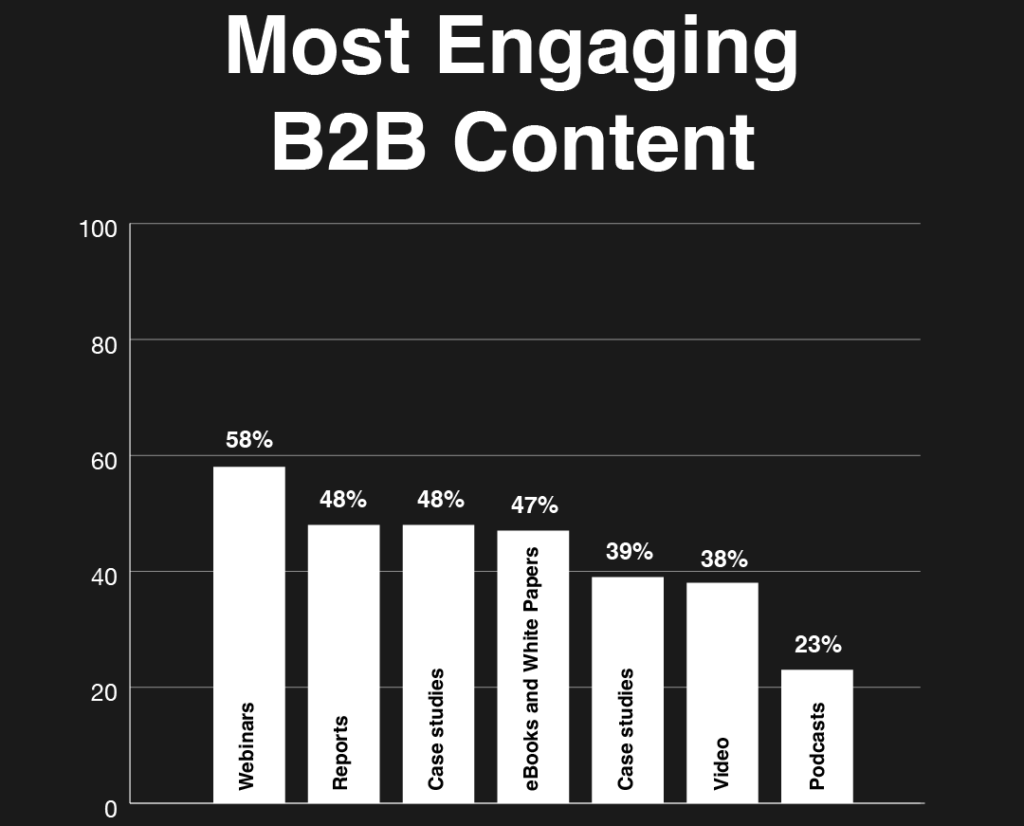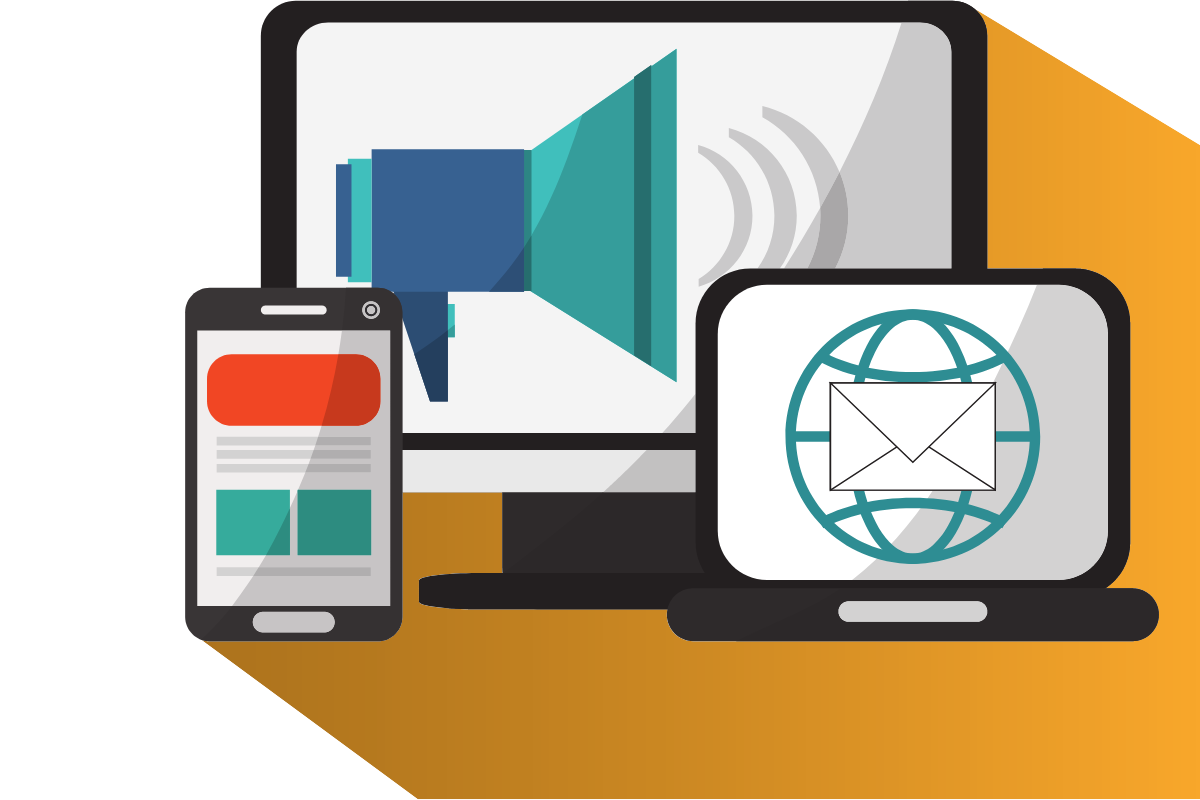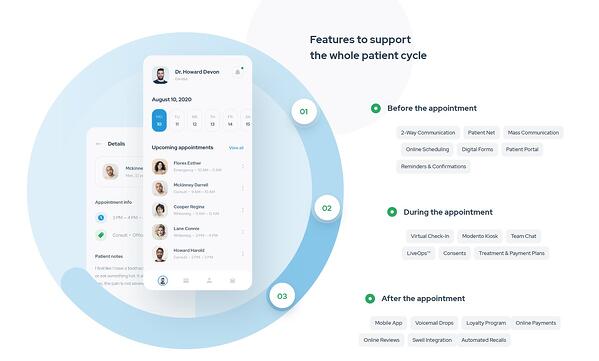When building a B2B lead generation campaign, content marketing might not be the first strategy marketers consider. Often, marketers rely on Google Ads, cold calling, and LinkedIn outreach to find and generate quality leads. While those marketing strategies are highly effective, they rely on a solid foundation of content.
Explore how to use content marketing for lead generation by building awareness and priming qualified leads.
What Is Content Marketing for Lead Generation?
A B2B lead generation strategy is identifying and connecting with potential buyers. For example, a marketer generates leads through lead magnets when they can save that buyer’s information for nurturing and eventually converting.
Some B2B lead generation examples include:
- Newsletter signups
- Webinars
- Contact forms
- Free trials or demos
In each situation, the buyers move from an anonymous audience to an interested lead. By engaging with marketing campaigns, the lead exchanged their contact information for something of value.
Content marketing lead generation strategies use content to convince readers. The readers then download or sign up for the lead magnet. According to a recent report, 70% of B2B marketers generate leads from content.
“70% of B2B marketers generate leads from content.“
How Content Marketing Complements Lead Generation
Content marketing is more crucial than improving a website’s ranking in search engines. It also raises awareness, builds trust, and moves potential buyers through the sales funnel. Without content marketing, lead generation strategies won’t be as effective.
Content marketing is more effective than ads, according to 80% of decision-makers. That’s because ads focus on a sale while content marketing builds relationships with the audience. Relationship building leads readers to fill out contact forms or download lead magnets, allowing marketers to add that lead to their database. Relationship building also improves the effectiveness of lead generation advertising campaigns.
Why Marketers Need a Lead Generation Content Strategy
Why should a marketer invest in lead generation content instead of sharing the lead magnet through ads and other strategies?
The B2B buyer’s journey is becoming longer and more complex. Marketers are having a more difficult time convincing decision-makers with a single ad or sales pitch. Instead, decision-makers want more research and data before making a sales decision.
Therefore, marketers won’t generate as many leads from lead magnets alone. Instead, they must connect and convince the B2B buyer through quality content. Content marketing lays the foundation of trust before the lead magnet, or lead generation strategy, and converts the buyer.
The Best Types of Lead Generation Content
While any content can generate leads, a few content formats perform better than others. The key to effective lead generation content is quality and research. B2B buyers are most interested in facts that prove why a business’s products or services are the best or specific ways a product will benefit their company.
Creating authority content builds trust and convinces B2B buyers to respond to the lead magnet.
The best B2B lead generation content includes:
- Case studies
- White papers
- Webinars
- Blog articles
- Videos
- Infographics
How to Use Content Marketing for Lead Generation
Use these 12 tips to build a highly effective lead-generation content marketing strategy to build trust and generate quality leads.
1. Establish Lead Generation Goals
A marketing team’s lead generation goals define the campaign’s direction and establish success benchmarks.
Marketers should define the number of leads they want to generate, the purpose of lead generation, the timeframe to generate the leads, and metrics to measure the campaign’s success.
Here are several lead generation goals B2B marketers might use:
- Generate revenue: Generating quality, conversion-ready leads. Measure the success by revenue generated.
- Increase brand awareness: Raising awareness about a brand. Measure the success of awareness campaigns through leads generated and increased website traffic.
- Build databases: Gather essential data to help in marketing strategies. Measure the success through changes in traffic, conversions, and customer experience.
Half of B2B content is for increasing brand awareness. The other half of the content is for nurturing and converting leads.
2. Research the Audience
Lead generation is only effective if the leads are potential buyers. For example, a company that generates 1,000 leads, but only two are B2B decision-makers, did not run a successful campaign. However, a company that only generated 200 leads but converted 100 of those leads had a highly successful lead generation strategy.
Generating the right leads starts with understanding whom to attract before running the lead generation campaign. Marketers create two types of audience identifiers:
- Ideal Customer Profile: A description of a fictional audience that would make the best buyer. It helps marketers understand WHO to reach and includes information like firmographics, location, and key decision-makers.
- Buyer Persona: A detailed outline of specific decision-makers helps marketers decide HOW to reach the audience. It includes motivators like pain points, job descriptions, and emotional triggers.
Marketers create these two profiles by looking at their current customer base, surveying their intended audience, looking at the competition, and examining third-party data.
“Generating the right leads starts with understanding whom to attract before running the lead generation campaign.“
3. Personalize the Content
Personalization is necessary for B2B marketing because it gives the audience a reason to care. According to 78% of consumers, personalized content increases purchase intent.
Personalization takes topics the audience might not be familiar with and turns them into relevant information. When customers see a business’s products and solutions apply to them personally, they’re more likely to respond to lead magnets.
For example, business-centric content would have titles like “5 Features of X Software.” Meanwhile, personalized customer-centric content would have titles like “5 Ways X Software Speeds up Business Operations.” The second option addresses topics from a customer’s viewpoint. It addresses specific challenges and shares customer benefits.
Personalizing content goes a step further than focusing on customers as a whole. Instead, marketers create content for specific customer segments.
For instance, a financial company will have different pain points than a marketing company. Therefore, marketers could address the same topics in their content in several ways to connect with each specific audience segment.
Account-based marketing is one of the more popular strategies B2B marketers employ for personalizing content. Account-based marketing uses ideal customer profiles to identify and target high-value accounts. Then, marketers create personalized content for those accounts to turn them into leads and, eventually, customers.
4. Use Relevant Topics
Keyword research is more valuable than a content optimization tool for search engine rankings. It’s also vital for attracting the right audience to content to ensure quality leads read and respond to the lead magnets.
Marketers use keyword research tools to identify search phrases their target audience uses. Then they create content around those keywords. Keywords research keeps the content relevant to the audience and improves the quality of leads the content generates.
For example, a B2B buyer searching for software solutions for their business will perform different searches than individuals researching software information. So, marketers would use keywords like “for businesses” and “business software” to attract decision-makers to the content.
5. Create Intent-Based Call to Actions
Keyword research also tells marketers the type of lead magnet to use in their lead generating content marketing.
For instance, a decision-maker performing a “how to” search is less likely to sign up for a free trial than a B2B buyer who searches “where to buy data management software.”
B2B audiences have four primary intents when looking for online content:
- Navigational: Using a company name in the search because the user is looking for a specific page
- Informational: Looking for general information or research
- Transactional: Someone ready to act who is looking for a particular product or solution
- Commercial: Someone who is interested in a product and is looking for more details
Marketers should customize their lead magnet based on the content keyword’s search intent. For example, informational keywords should have a soft call to action, like encouraging the reader to sign up for a newsletter for more information or joining a webinar.
Conversely, transactional and commercial keywords should have a more significant call to action, like signing up for a free trial.
6. Focus On Quality over Algorithms
While keywords are essential for lead generation, the content’s quality plays a more significant role in ranking the content and converting the reader. Bringing the right leads to marketing content is half the battle. The content needs to convince those readers to perform the call to action.
Quality content with industry-leading ideas, authority links, and expert advice will build trust with the reader. Then, when the reader arrives at the lead magnet, they are more likely to respond to the call to action.
7. Create a Full Funnel Strategy
Lead generation can occur at every stage of the buyer’s journey. Sometimes marketers might connect with leads who just met the brand. Other times a business will generate leads who are ready to make a purchase decision.
The most effective content marketing for lead generation combines the journey stage with the buyer’s persona.
“The most effective content marketing for lead generation combines the journey stage with the buyer’s persona.”
8. Make Conversions Easy
Businesses will generate more leads if the lead magnet is clear. For example, content creators might design a banner that attracts attention to the lead magnet.
Otherwise, content writers may make the lead magnet a bold sentence with a link to a webinar, contact form, or other lead magnets. This more subtle option is more effective for a top-of-the-funnel lead generation for raising awareness.
9. Incorporate Multimedia
Multimedia content performs best because it’s more engaging. The audience is more likely to act on the call to action when the content beforehand is engaging.
Some of the most engaging forms of B2B content based on the percentage of marketers who used the asset include:
- Webinars (58%)
- Reports (48%)
- Blog posts (48%)
- eBooks and White Papers (47%)
- Case studies (39%)
- Video (38%)
- Podcasts (23%)

In 2022, 69% of B2B marketers increased their video marketing investment as that format is quickly becoming one of the most effective marketing strategies.
Marketers often combine formats to boost the performance of the content. For example, a content creator might embed a video in a blog post. That way, marketers are more likely to connect with the target audience and generate quality leads.
10. Use Creative Distribution Strategies
Once marketers create quality content, they must find ways to get it in front of the ideal audience. This task isn’t always as simple as choosing popular keywords. In reality, 90.63% of web pages don’t see any organic search traffic.
Marketers that want to ensure their ideal buyer sees the content and responds to the lead magnet must use more targeted distribution strategies.
Content syndication is highly effective for reaching buyers and raising brand awareness through lead-generation content. Content syndication is sharing content on third-party platforms. For example, a business might republish a blog post on LinkedIn, distribute it across targeted websites through Netline, or post it on a public site like Medium.
“Content syndication is highly effective for reaching buyers and raising brand awareness through lead-generation content.”
These distribution channels allow marketers to reach their audience by sharing content on sites they know the audience regularly visits. Through content distribution, marketers can go to the B2B buyers rather than wait for the buyers to come to them.
Other ways to distribute content to a target audience include email marketing, newsletter sharing, and social media posting. Those three channels are the business’s personal connections to reach interested buyers. So marketers can create middle and bottom-of-the-funnel lead generation content, like promoting trial signups.
11. Track and Analyze the Results
Marketers use the metrics they established in their goals to track and analyze their results. For example, tracking content performance helps marketers know what content is performing best and when to optimize the content.
Marketers often run several versions of the same content to see which version performs best. Businesses call this A/B testing. For example, content creators might compare the webinar signups from a link to a banner ad in the content to see which call to action readers prefer.
12. Continually Update the Content
After investing hours into a B2B lead generation marketing strategy, marketers want the content investment to work as long as possible. Regularly updating content helps content continue to perform well and generate quality leads.
Updating content includes:
- Refreshing the writing
- Adding updated statistics
- Adjusting content optimization to new search engine rules
More and more businesses are including content updates in their content marketing strategy because updated content delivers consistent positive results and new leads.
Review Your Lead Generation Strategy
Behind the Work is a team of expert marketers with the tools and knowledge to create, distribute, and measure expert content that generates quality B2B leads. The marketing strategies attract and acquire a specific target audience to boost conversion rates.
Have an expert marketing strategist review your strategy today.

 Contributed by Cailey Kidman
Contributed by Cailey Kidman
























